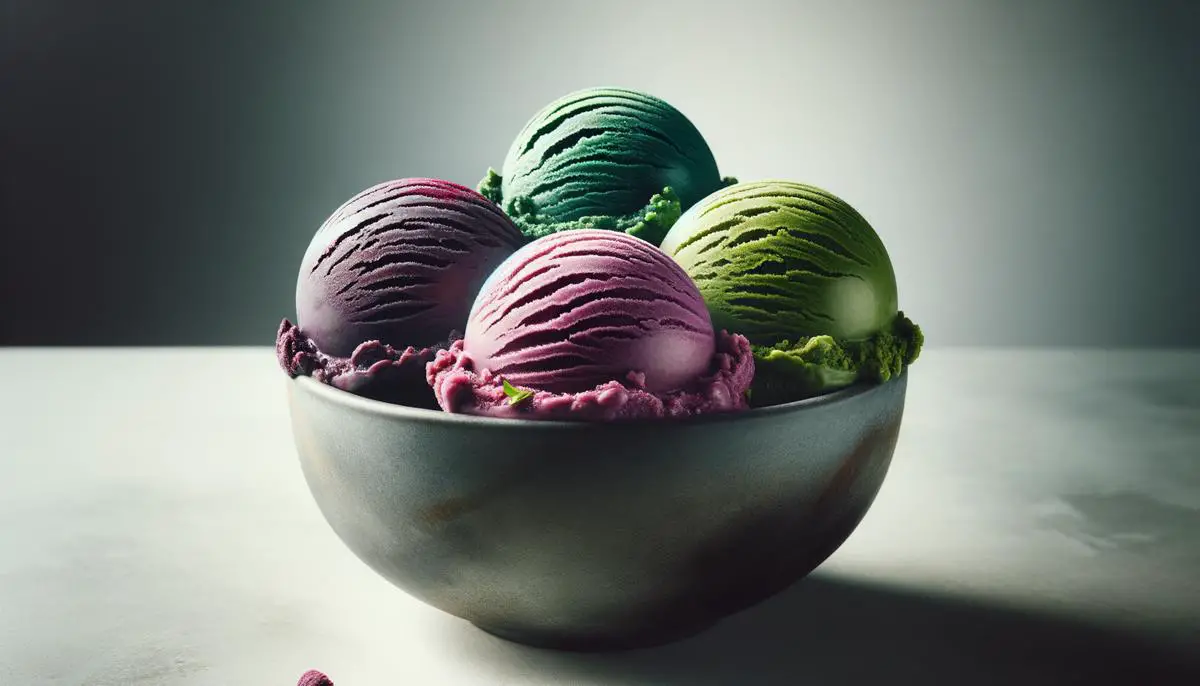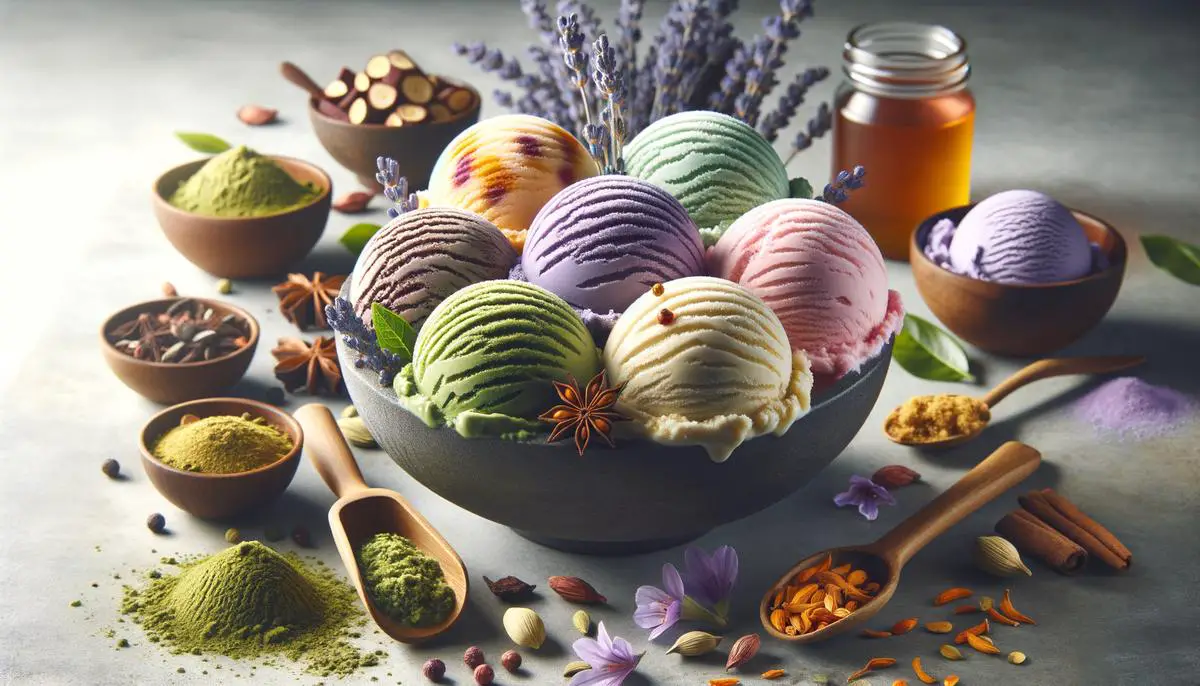
Consumer Preferences and Nostalgia in Ice Cream Flavors
Research from the International Dairy Foods Association (IDFA) reveals how nostalgia drives many consumer choices. Traditional flavors like vanilla, chocolate, and strawberry serve as comfort zones, reminiscent of simpler times. This isn't just about taste but a deep-seated emotional connection to those flavors that made our childhoods unforgettable. The roots of such preferences run deep, reaffirming why these classics remain unwavering on the popular list.
Further exploration into consumer preferences shows an openness to newer flavors suggesting consumers love a twist on the ordinary. Novelty brings excitement, which can't be underestimated in today's fast-paced world. This is especially noticeable during periods of celebration or comfort-seeking phases, where the right scoop can evoke powerful memories.
Brands leverage nostalgia by blending modern trends with traditional comforts. Think ice cream that takes you back to the summers of your youth while serving a sophisticated adult palate. Products like cookie dough ice cream capitalize on these memories, offering chunks that remind us of sneaking dough from the mixing bowl as children.
Retailers and manufacturers should remember this balancing act when designing their offerings. Maintaining classic staples while innovating with trendy twists ensures they meet the broad spectrum of consumer desires. Such a strategy echoes Jeni's Splendid Ice Creams' success, which mixes offbeat flavors like everything bagel with beloved classics, catering to both traditionalists and adventurers.
Let's also not ignore the concept of "snackification." With the introduction of grab-and-go options, including ice cream sandwiches and cones in whimsical forms, consumers can enjoy their favorite flavors in convenient, novel ways. This push into the snack realm makes ice cream relevant beyond its traditional consumption times.
Understanding and adapting to these perpetual changes in consumer behavior is crucial. As brands navigate these trends, it's clear that nostalgia remains a powerful influence, coaxing consumers toward flavors that remind them of simpler, happier times. But don't just stop there. Keep pushing boundaries with innovative flavors that surprise and delight. The combination ensures both market stability and growth, satisfying customers' craving for the familiar while enticing them with the new.

Innovation and Technology in Ice Cream Flavor Development
The landscape of ice cream flavor development has evolved dramatically, driven by technological advancements and a keen eye on consumer trends. Manufacturers are leveraging flavor science and sophisticated techniques to craft innovative and unique ice cream experiences that dazzle the palate.
Consider the recent winners of the IDFA's Innovative Ice Cream Flavor Competition. The accolades went to:
- Peanut Butter Overload by Windy Knoll Farm Market
- Banana Pudding Eclair by Hershey's Ice Cream
- Insta Graham from The Ice Cream Club
These flavors showcase a mix of indulgence and novelty, meticulously engineered to evoke excitement and pleasure, a direct result of comprehensive market research and cutting-edge technology.
Beyond the traditional scoop, experimental trends are making waves. Internationally inspired flavors capture the hearts of those eager to sample the world through ice cream. Think Thai rolled ice cream or balsamic-glazed figs swirled into mascarpone. These flavors provide a global gastronomic experience wrapped up in a familiar, yet exotic treat. It's an exciting fusion of cultural taste profiles that introduce consumers to new culinary landscapes without leaving their hometown scoop shop.
Adult-themed flavors are another burgeoning trend. From the intricacy of bourbon-infused ice cream to the elegance of espresso martini scoops, these creations cater to a more mature audience seeking sophistication. Alcohol-infused delights and carefully crafted coffee blends transform ice cream into an experience that's as adult in its nuances as it is childlike in its indulgence.
Savory and salty flavors also break the mold, pushing the boundaries of what ice cream can be. These flavors defy traditional sweetness, opting instead for complex umami profiles and gustatory surprises. Imagine caramelized onion or sea salt rosemary as contenders that redefine our understanding of this beloved dessert. These innovations hinge on advanced flavor technology, with scientists and chefs collaboratively sculpting profiles that balance novelty with palatability.
The role of proprietary research cannot be overstated. Companies like Cargill utilize extensive consumer insights to guide their product development. Through sophisticated data collection and analysis, they tap into the evolving desires of their audience, ensuring new products hit the mark. Such research reveals, for instance, that consumers are increasingly drawn to multi-sensory experiences—flavors with textures and inclusions that transform eating into a tactile journey.
Artisanal and small-batch creators also benefit from this research, often finding ways to craft unique offerings that larger manufacturers might overlook. Technology has democratized innovation, allowing even small players to experiment with and perfect their ice cream concoctions, whether they're using advanced emulsifiers for creamy plant-based options or novel sweeteners that maintain indulgent flavors without the added sugars.
In this continually evolving market, it's critical for manufacturers to balance tradition and innovation adeptly. Harnessing cutting-edge technology, from flavor matching techniques to the latest in fat mimetics, they can offer consumers an array of choices that satisfy the familiar while tantalizing with the unexpected. By transforming simple pleasure into complex enjoyment, these innovations ensure the ice cream industry remains dynamic, diverse, and delicious.

Health and Wellness Trends in Ice Cream
As consumers become more health-conscious, the ice cream industry is witnessing a significant shift towards plant-based, non-dairy, and health-focused options. These trends are firmly carving a place in the market, driven by a blend of consumer demand and innovative advancements by prominent companies like Glow Superfoods and Cargill.
Plant-based ice creams are no longer niche products. They have moved into the mainstream, offering delicious alternatives that cater to:
- Vegans
- Lactose-intolerant individuals
- Environmentally conscious consumers
Brands like Glow Superfoods are leading the charge with their range of plant-based ice creams that do not compromise on flavor or texture. Utilizing ingredients like coconut milk, almond milk, and oat milk, they've crafted rich, creamy bases that mimic the mouthfeel of traditional dairy ice cream.
Glow Superfoods takes this a step further by incorporating superfoods and functional additives into their products. Think antioxidant-rich acai, nutrient-dense spirulina, and energizing matcha. These ingredients provide health benefits and add unique flavors, appealing to consumers looking for ways to indulge without guilt. Their approach resonates with the growing demographic that prioritizes health and holistic wellness.
Cargill has made significant strides in the development of plant-based ingredients and functional additives. Their Puris 2.0 pea protein enhances the nutritional profile of ice cream and improves texture and creaminess, making plant-based offerings more comparable to their dairy counterparts. Moreover, Cargill's suite of stevia-based products allows manufacturers to create low-sugar ice creams that maintain the sweetness and indulgent experience consumers crave.
The trend towards cleaner labels is equally noteworthy. Consumers are increasingly scrutinizing ingredient lists, favoring products with fewer, more natural ingredients. This has driven manufacturers to remove unnecessary additives and preservatives, opting for transparent labeling that speaks to purity and simplicity. It's about providing assurance that what consumers are eating is wholesome and minimally processed.
Balancing health benefits with indulgence is a delicate art. While health-focused consumers are mindful of their intake, they do not wish to sacrifice the joy that comes with eating ice cream. This is where the concept of permissible indulgence shines. Manufacturers like Cargill are responding by creating products that are both indulgent and health-oriented. Their Go!Drop fat technology, for instance, enhances mouthfeel and creaminess in low-fat ice creams, marrying the sensory pleasure of traditional ice cream with a healthier profile.
The demand for functional ingredients is also on the rise. Consumers are looking for added benefits from their indulgences. Ingredients that support gut health, like probiotics, or those that provide a boost of energy, such as ginseng, are becoming popular. These functional additives turn a simple treat into a product that contributes positively to one's health routine.
Moreover, the sustainable production of these ingredients is gaining importance. Consumers are not just interested in what's in their ice cream but also how it's made. Companies are adopting sustainable sourcing and production practices, which appeal to eco-conscious consumers and align with broader environmental goals.
Incorporating these trends requires a nuanced approach to product development. It's about understanding the interplay between health, indulgence, and sustainability. Brands that can effectively balance these elements will satisfy current market demands and set trends for the future.

Global Perspectives and Market Insights
Ice cream flavors and innovations transcend borders, inviting global culinary influences to transform the humble scoop into a passport to exotic locales. Across the world, exciting flavor launches and regional specialties captivate consumers, each region offering its unique twist on this beloved treat.
In Japan, the art of ice cream-making finds itself intertwined with traditional tastes and contemporary quirks. Flavors like matcha green tea and black sesame provide a harmonious blend of traditional Japanese ingredients with modern ice cream technology. Ube (purple yam) ice cream, hailing from the Philippines but gaining popularity in various Asian markets, delights with its vibrant hue and subtly sweet, nutty flavor. Japanese soft serve also occasionally surprises with savory variants such as soy sauce or wasabi-infused scoops, catering to adventurous palates.
Brazil, on the other hand, brings its own tropical flair to the global ice cream scene. Flavors like açaí, passion fruit, and guava reflect the country's bounty of tropical fruits. Local brands like Oggi Sorvetes collaborate with culinary masters from shows like "MasterChef Brasil" to develop innovative flavors such as caipirinha (the nation's famed cocktail) and brigadeiro (a chocolate fudge truffle), thrilling both locals and tourists alike.
Across Europe, we see a resurgence of artisanal and small-batch gelato makers focusing on high-quality, locally-sourced ingredients. Italian gelato artisans, revered worldwide, continue to enchant with flavors like balsamic-glazed figs and mascarpone or the seasonal favorite, pistachio cream, hand-churned with nuts sourced from Sicily. Meanwhile, in France, lavender honey and brioche ice cream reflect the country's rich culinary heritage.
Countries like India contribute to the global flavor palette with ice creams inspired by their rich dessert traditions. Saffron and cardamom, commonly found in Indian sweets like kulfi, are increasingly making their way into ice cream concoctions, providing a spice-laden twist to the creamy delight.
Euromonitor's data paints a picture of a global market eagerly expanding its flavor horizons. The market projects strong growth with a consistent 4.4% CAGR over the next three years, driven by both take-home and impulse ice cream segments.1 The Barry Callebaut proprietary study of 2023 adds depth to this, revealing that 75% of global consumers exhibit a readiness to try new and exciting ice cream experiences, validating this trend of flavor experimentation.2
North America isn't exempt from this global fervor. Brands like Van Leeuwen in the US push the boundaries with limited-edition "shock flavors" such as Hidden Valley Ranch and Kraft Macaroni & Cheese, demonstrating an intriguing blend of curiosity and nostalgia. While these flavors stir conversations and social media buzz, they underscore the growing consumer appetite for novelty, even as traditional favorites hold strong.
Even in more conservative markets, flavor innovations are finding their footing. In the United Kingdom, hits like honeycomb and rhubarb crumble gelato reflect the classic British affinity for desserts, reimagined in frozen form. Similarly, Mexican flavors inspired by local ingredients like tamarind, mezcal, and cajeta (caramelized goat's milk) are becoming popular, pushing the boundaries of traditional ice cream flavors and showcasing the nation's rich culinary heritage.
Such global exchanges of flavors highlight an exciting culinary exchange, as consumers become more adventurous in their tastes. Advanced flavor matching techniques and sustainable ingredient sourcing further catalyze this cultural cross-pollination, providing flavors that are authentic and respectful of their origins but accessible to palates worldwide.
This is not just a passing trend but a significant shift reflecting deeper consumer engagement with food as an experience. As brands adapt to these global influences, they diversify their offerings and enrich the cultural tapestry that ice cream represents. The future promises an expansive array of flavors that cross borders, tantalize taste buds, and bridge traditions with modern gastronomic science.

- Euromonitor International. Ice Cream and Frozen Desserts: Global Market Overview. Euromonitor International; 2023.
- Barry Callebaut. Sweet Insights: 2023 Global Ice Cream Trends. Barry Callebaut; 2023.



